There are 18 species of snakes in New York. Growing urbanization and a reduced natural habitat are the threats snakes face in New York.
Almost half of the snakes in the state now have an endangered or threatened status.
Various types of predators such as birds lead to a smaller number of snakes. Growing industries and housing projects also diminish the natural habitats of the state-native species.
Some of the most common Northeastern territories species live here but New York doesn’t house as many snake species as other states in the region.
Snakes live in woodlands and long water sources in New York. Clean water surrounded by vegetation is one of the preferred habitats of dangerous venomous snakes still living in the state.
Table of Contents
Are There Venomous Snakes in New York?
Most snakes in New York aren’t venomous. There are still a few species that can be highly venomous to humans around the state.
Timber Rattlesnakes and Massasauga snakes are among the most common venomous species in the state.
Medical attention is needed against the venomous bite of these species.
Other snakes such as The Common Garter Snake are mildly venomous. These native New York snakes have venomous saliva which may still be painful but doesn’t lead to medical complications.
Snakes in New York
1. Common Garter Snake
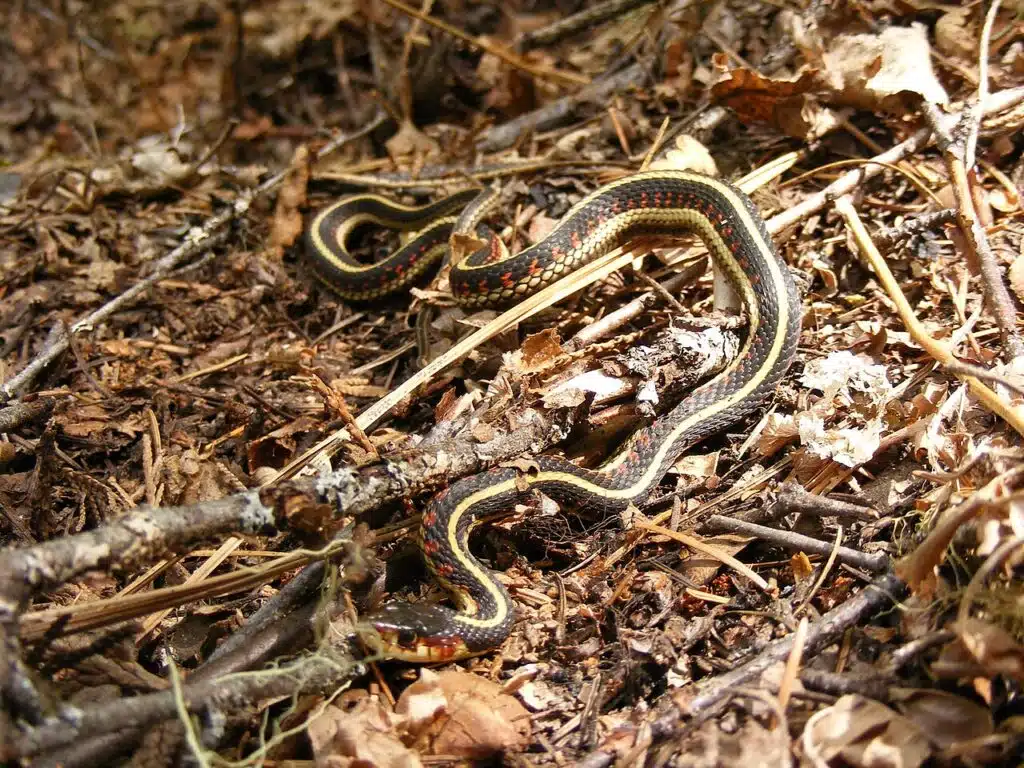
Common Garter Snakes (Thamnophis sirtalis) are New York’s most numerous species.
The snake is spotted on the edges of woodlands and occasionally around homes. It prefers to hide in vegetation whenever spotting people.
You can identify this species by its color, blotches, and stripes.
While Common Garter Snakes come in different colors, dark green is one of its most common colors.
3 yellow or cream-colored stripes are specific to this snake, together with darker blotches.
Common Garter Snakes generally grow to 50 inches with some of the largest members of the species holding a record length of 4 feet.
A shorter size is specific to the Common Garter Snakes found around New York. The species measures around 20 inches here, with some of the largest New York Common Garter Snakes measuring around 30 inches.
It’s best to stay away from this snake whenever spotted around the state as it can bite.
Common Garter Snakes have venomous saliva or mild venom, compared to other species.
Its bite can be dangerous to small amphibians but it doesn’t impact the health of humans.
In rare cases, the venomous saliva of the Common Garter Snake can lead to itchy swollen skin in the area of the bite.
2. Common Watersnake
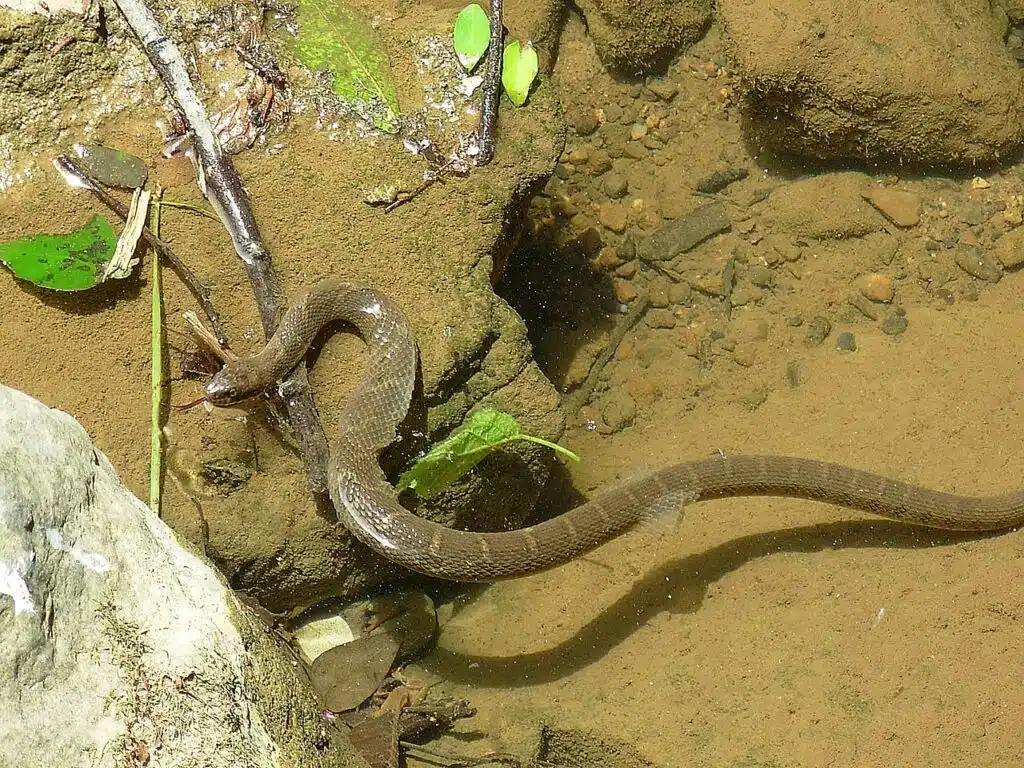
Common Watersnakes (Nerodia sipedon) are one of the most numerous species in New York and the most common watersnake in the state.
It has different colors such as gray and green and it can be identified by its black dorsal blotches.
The species grows to an average size of around 2 feet and it may be sometimes misidentified as a venomous snake.
Found around streams and other bodies of water, this snake always makes a quick escape into the water when seeing humans as it tries to avoid contact.
Common Watersnake bites are rare and without repercussions, to humans, as the species is non-venomous.
Wetlands, permanent ponds, and large and small streams are the natural habitat of the species.
Adapted to semi-aquatic living, the Common Garter Snake often prefers multiple bodies of water.
Adults venture to larger bodies of water while juveniles live around small streams or small ponds where they can escape faster.
Predatory birds are among the species juvenile snakes of the species face the most.
Frogs and toads are also common predators of these juveniles.
Female Common Garter Snakes give birth to young snakes instead of laying eggs.
Various numbers of juveniles are born each year. A mature female gives birth to 7-9 live young snakes in the fall.
3. Eastern Milksnake
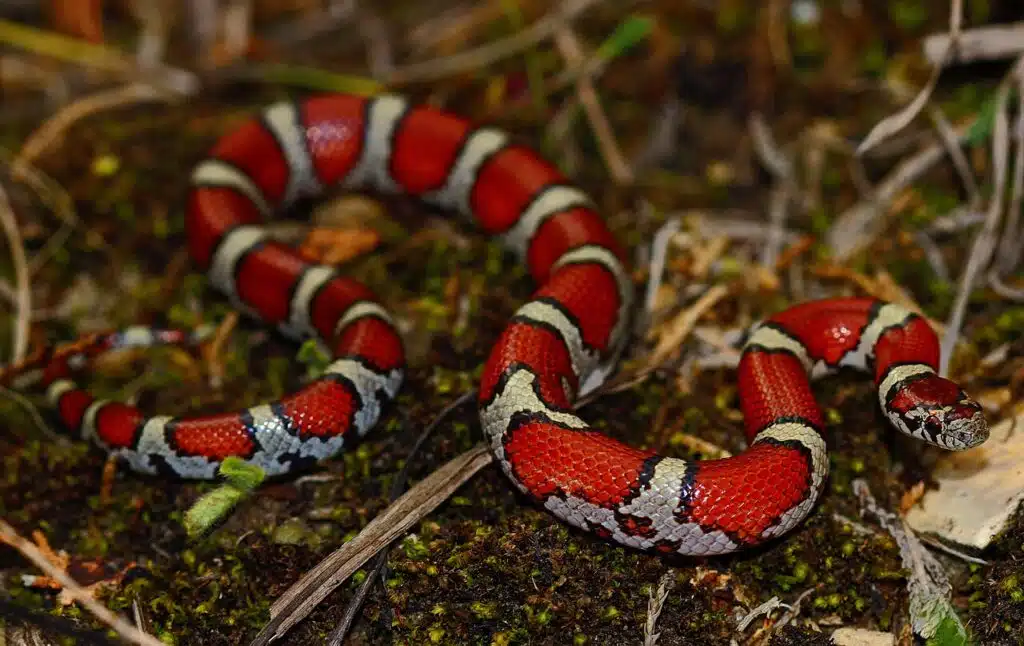
Eastern Milksnakes (Lampropeltis triangulum) are some of the most common species spotted by locals.
The habitat of the species often overlaps human settlements which makes the species appear even more common.
This species chases rats and mice into buildings. It can be found in barns and other man-made structures where rodents seek food and shelter.
Eastern Milksnakes are known as Spotted Adders in New York.
These snakes are dominated by contrasting colors. A base white to gray color is specific to Eastern Milksnakes.
Red blotches cover the body. These red blotches contrast its white body as they also have black margins.
Snakes in New York are known as efficient predators that swallow prey alive.
Eastern Milksnakes are common exceptions as they constrict prey before eating it.
Wrongly associated with a species that consumes milk, this snake suffocates rodents before eating them.
While a medium to large species in many habitats across the state, this species only eat small rodents it can easily suffocate.
Eastern Milksnakes measure around 2 feet with a few larger exceptions across the state.
This snake may be encountered in multiple habitats except for the Northern and Northeastern parts of New York where it’s still present, but it has considerably smaller numbers than across the state.
4. Dekay’s Brownsnake
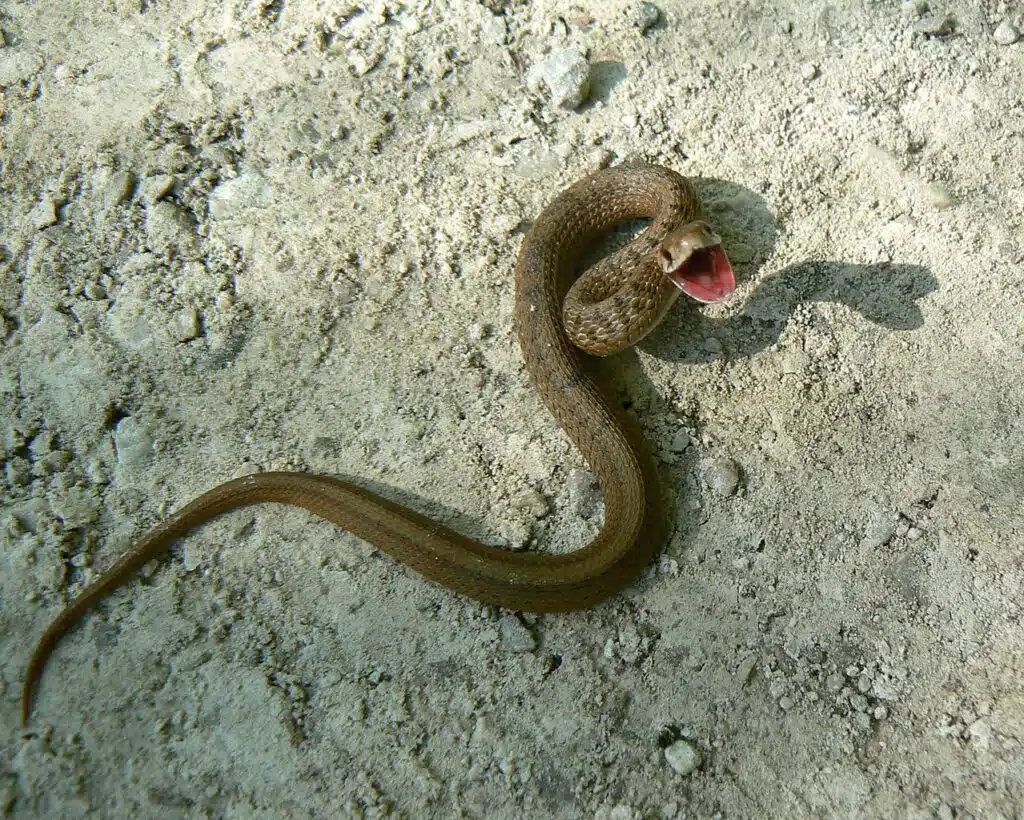
This snake species (Storeria dekayi) has first been discovered in New York.
It was the American zoologist James Ellsworth De Kay who first spotted and collected this species in Long Island.
However, Dekay’s Brownsnake is a species common all across the Eastern half of the United States.
Small differences in this snake’s diet are noted in New York as opposed to other regions of the country.
Slugs form the bulk of this snake’s diet across the state.
As an adapted species, Dekay’s Brownsnake can even remove the shells of slugs with its mouth before swallowing its prey.
This snake species has a brown color and is known to be very specific about its diet at ground level.
It may only eat earthworms outside of New York.
Dekay’s Brownsake is a small species that can live at various altitudes up to a few thousand feet.
Its brown coloring makes the species a camouflaged snake that isn’t easy to spot for its predators.
As with most snakes, it’s the juvenile stage of the species that mostly exposes it to predation.
This type of snake is known for falling prey to toads and birds in its early days.
Even some of the larger snakes of New York can eat juvenile Dekay’s Brownsnakes.
5. Eastern Ratsnake
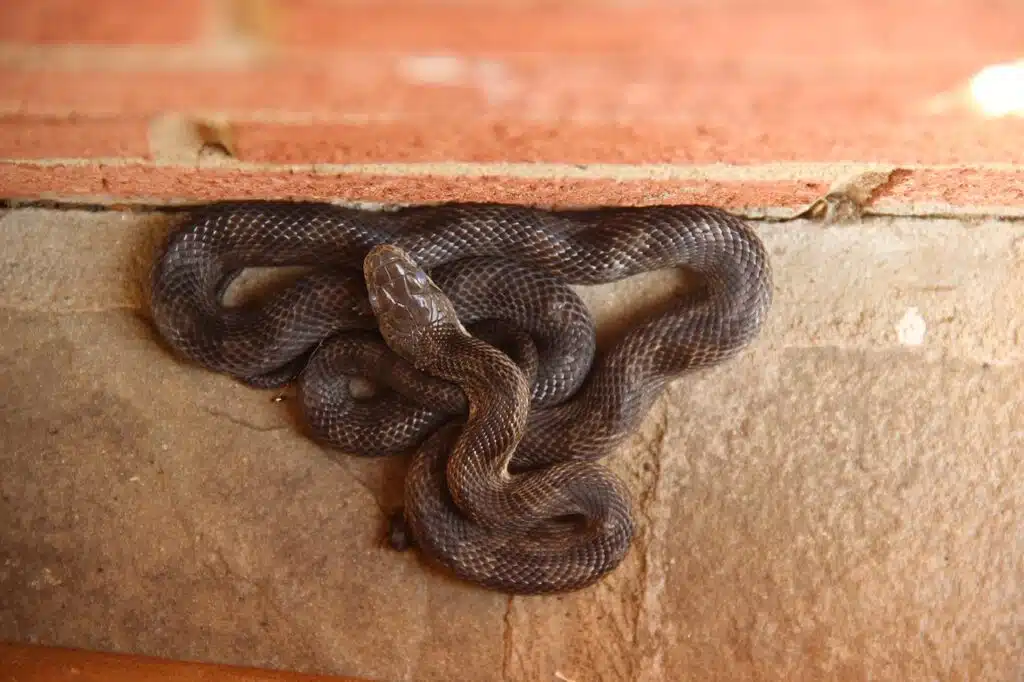
Some of the snakes with the most expansive North American habitats are Eastern Ratsnakes (Pantherophis alleghaniensis). Present in New York, this is a species that often grows more than 42 inches.
Most Eastern Ratsnakes in the state have an average length of around 55 inches. Only the largest snakes of the species grow longer than 70 inches.
Known for having multiple colors, including an orange color, the Eastern Ratsnake is an adaptable species living in different habitats.
This species lives both in wet and dry lands but it shows a preference for woodlands and the edges of woodlands.
Pine woodlands are among its favorites as this species can even live at high altitudes.
While not venomous, Eastern Ratsnakes can bite if cornered.
Their main goal is to make a quick escape. However, the species is still not known for avoiding confrontation.
It arches its body and wiggles its tail on the ground, making noise while it strikes.
Juveniles of the species might also attempt to bite when cornered or roughly handled.
A diverse diet is specific to this species. Rodents are among its favorites.
Given it lives around woodlands, the Eastern Ratsnake also eats lizards.
The species has stable numbers across the state and a widespread presence on The East Coast, down to Florida.
6. Ring-necked Snake
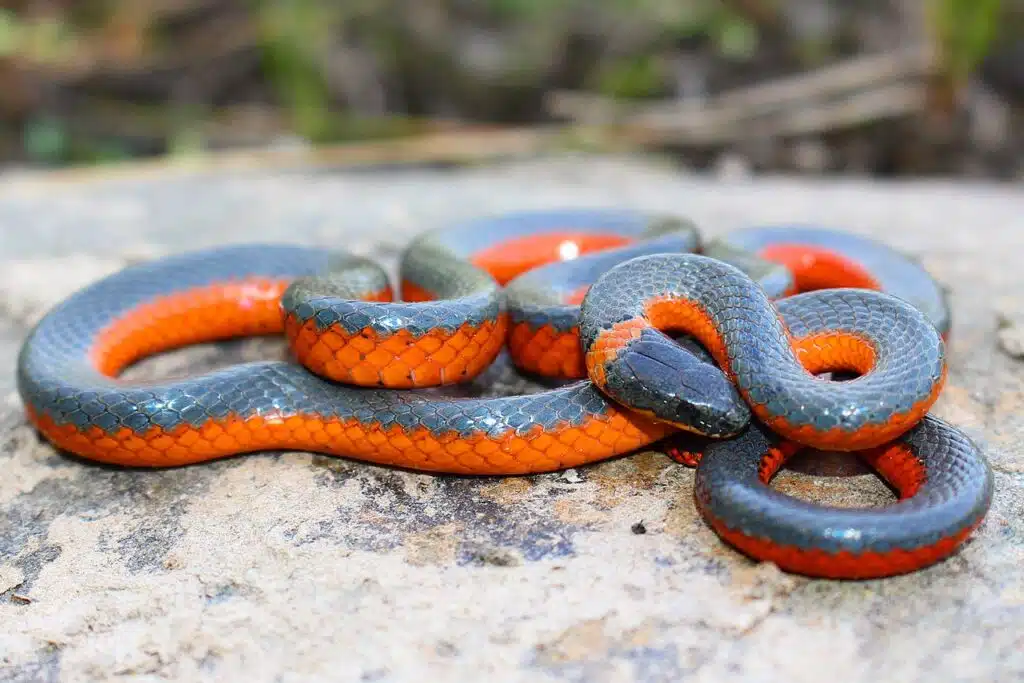
Colubrid Ring-necked Snakes (Diadophis punctatus) are one of the most common small species in New York.
This is a species that typically measures up to 18 inches as an adult.
It survives multiple years and the species can be considerably smaller at first. As a juvenile that hasn’t passed its first year of life, Ring-necked snakes might only measure around 10 inches.
The species can be distinguished from other small species by its orange-red ventral color.
It uses this vivid color as one of its few self-defense measures.
Ring-necked Snakes roll over showing their orange underside whenever threatened, in an act that makes them look dead and also poisonous.
This small snake isn’t venomous or poisonous to its predators.
Ring-necked Snakes can only eat small prey, due to their thin bodies.
Small salamander is one of the first types of prey it finds under leaves and around woodlands.
Snakes of this family also eat slugs, similar to other species in the state.
Ring-necked snakes might have contrasting body coloring but they are rarely seen.
A highly nocturnal species, this snake lives mostly secretive lives away from the eyes of humans.
7. Red-bellied Snake
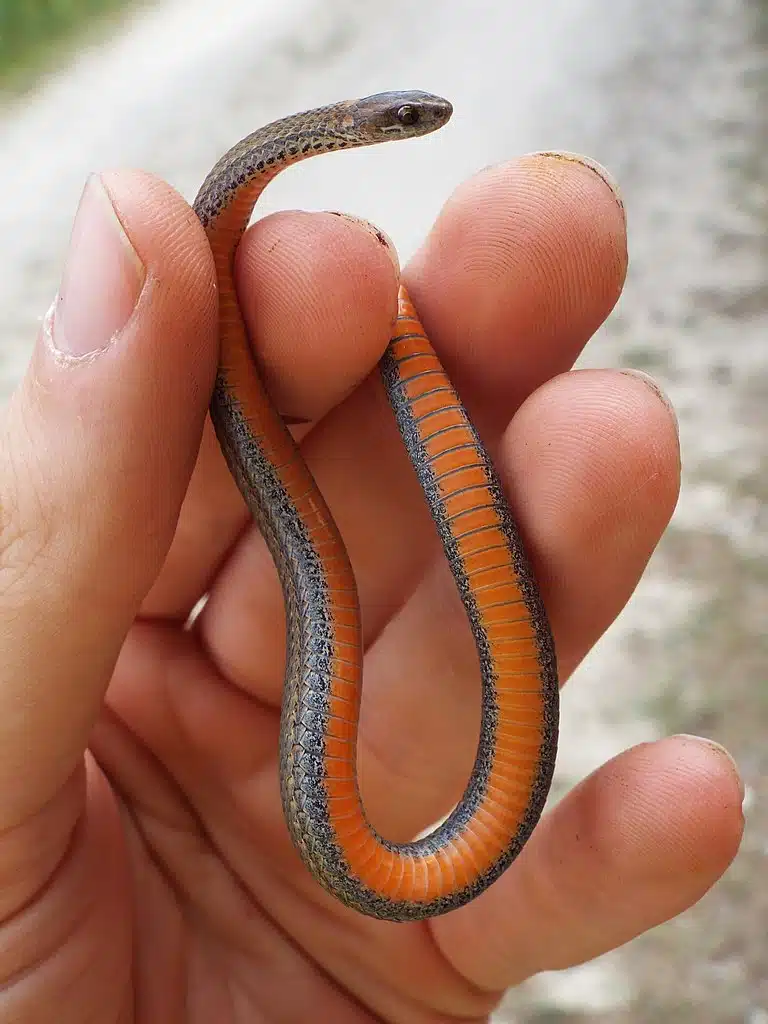
Red-bellied Snakes (Storeria occipitomaculata) are also known as Northern Red-bellied Snakes or Fire Snakes across the state.
This is a species with a brown chestnut-like dorsal color and a red ventral color.
Coloring-wise and size-wise, the Red-bellied Snake bears resemblance to the Ring-necked Snake.
Across New York, Red-bellied Snakes are also some of the smallest species you can come across.
This snake may grow up to a length of 12 inches but it rarely reaches this length as many measures around 10-11 inches.
Red-bellied Snakes don’t grow a lot since their birth. They are born measuring at least 7 inches which means they don’t even double their length in their lifespan.
This species is also one that doesn’t live long compared to some of the larger snakes in the state.
It survives up to 4 years in the wilderness.
The reduced length and the slender shape of this specie also dictates its diet.
It feeds on small slugs and earthworms across woodlands.
Most Red-bellied Snakes feed and live in open land between woodlands, preferably a moist habitat.
8. Timber Rattlesnake
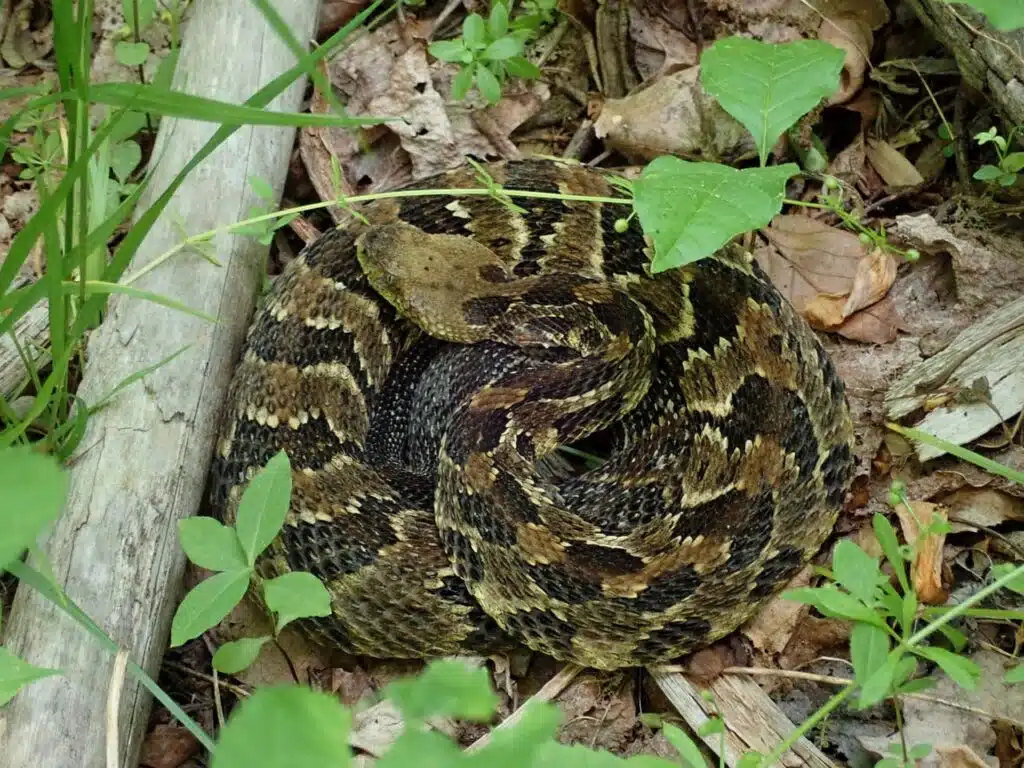
Multiple snake species (Crotalus horridus) common in other states have a special status in New York.
This is also the case with the now threatened Timber Rattlesnake.
This is one of the most common venomous snakes in the state, showing signs of diminishing populations through a diminishing habitat.
Timber Rattlesnakes are now facing a threatened status in most dens across the state that have been monitored by researchers.
Almost extinct from its oldest dens, Timber Rattlesnakes are some of the most dangerous in New York.
This species is highly venomous and known for its necrotic venom.
It grows to various sizes from 36 to over 70 inches.
Timber Rattlesnakes come in gray or brown base colors with dark or black blotches across the body.
Females of the species are considered even more dangerous as they can be sometimes spotted out in the sun.
They warm up in direct sunlight, often resting on limestones or other warmed-up surfaces.
Females and males are known to overwinter in dens with other snakes. They can also use crevices as sheltered overwintering spots.
9. North American Racer
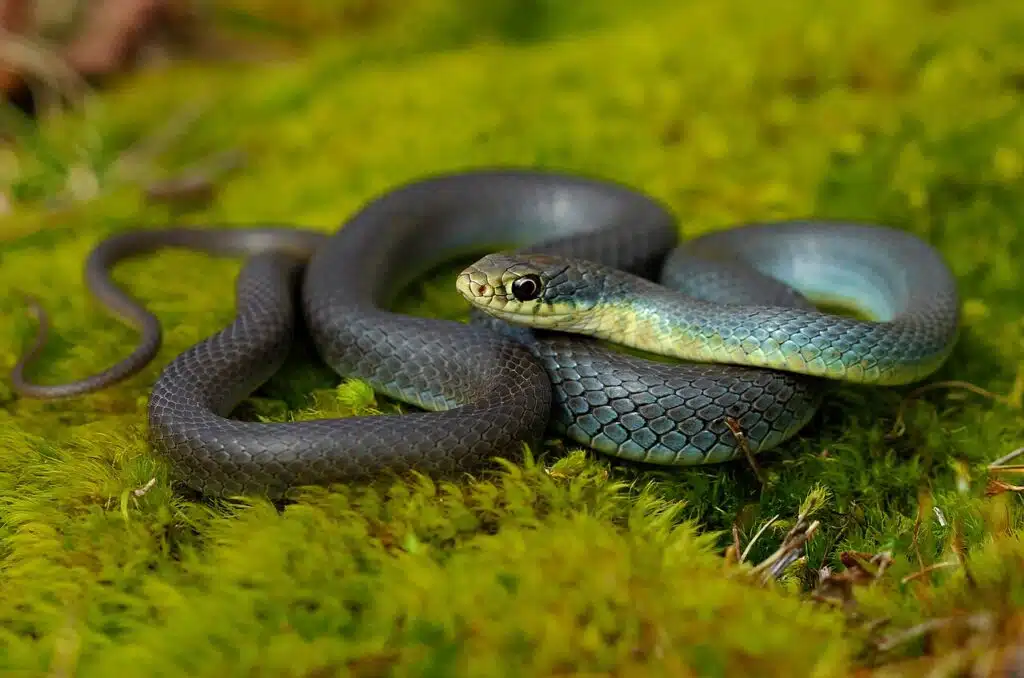
North American Racers (Coluber constrictor) are a highly common species of snakes across the state.
This is a mostly black or blue-black snake that grows to a size of at least 20 inches as an adult.
Almost black, the snake has a non-venomous nature and an adaptive spirit that finds it across dry lands and humid habitats.
North American Racers are also spotted on sandy territories.
This species is known to be found around woodlands, including cypress woodlands.
Adaptable but still relying on its personal preferences, the North American Racer is mostly found around new woodlands.
Areas around the state going through reforestation are known to attract the highest numbers of North American Racers.
This species is one of the snakes that enjoys conservation policies in many areas of North America.
North American Racers are some of the fastest snakes in the state.
They look for small prey they immediately move towards.
Constriction is used by the snake before swallowing prey.
Female North American Racers lay an egg as they don’t carry live young. Eggs are laid in the ground around June-July.
Varying numbers of eggs are laid by each female.
A larger North American Racer female can lay more eggs.
10. Ribbon Snake
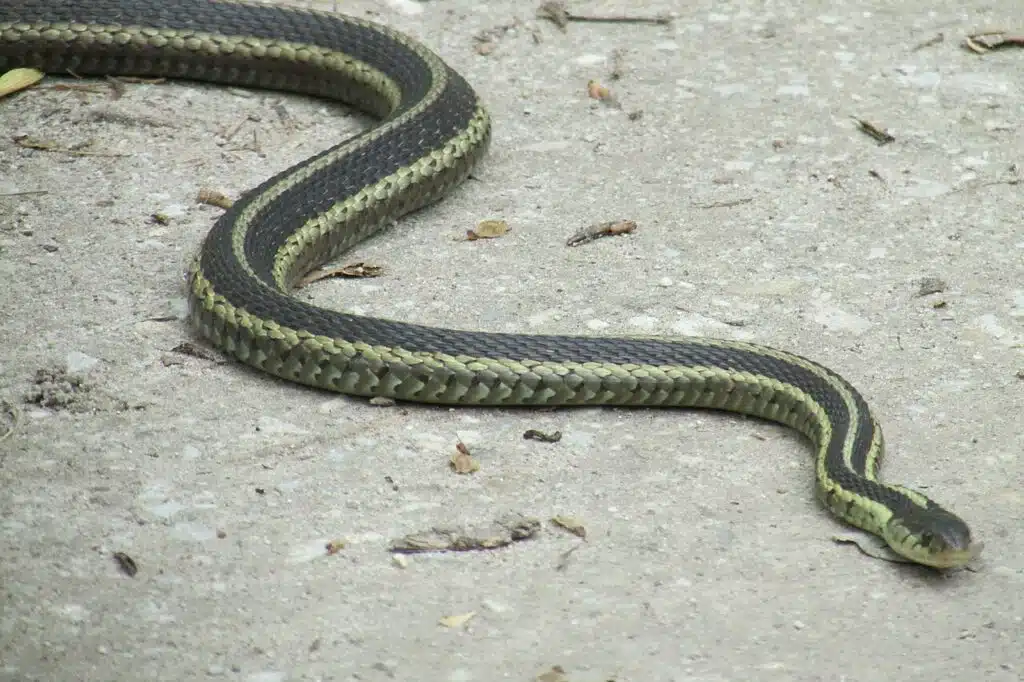
Ribbon Snakes (Thamnophis saurita) get their names from the long ribbons across their bodies. This is a species that’s either brown or various shades of green with bright stripes across the body.
Ribbon Snakes are among the most common aquatic species in New York.
They like areas around water that feature sufficient tall vegetation to hide in. A striped appearance makes this species difficult to spot when hiding in the vegetation.
The species is known for swallowing all types of prey such as amphibians.
Young snakes of the species cannot swallow many types of prey adults feed on. Still, they are born with a larger head so that they can eat small salamanders, toads, and even fish.
These types of snakes typically make a quick water escape whenever facing humans.
Females Ribbon Snakes give birth to live young. The number of young snakes varies.
Some females may give birth to just a few snakes while others give birth to tens of snakes at once.
11. Gray Ratsnake
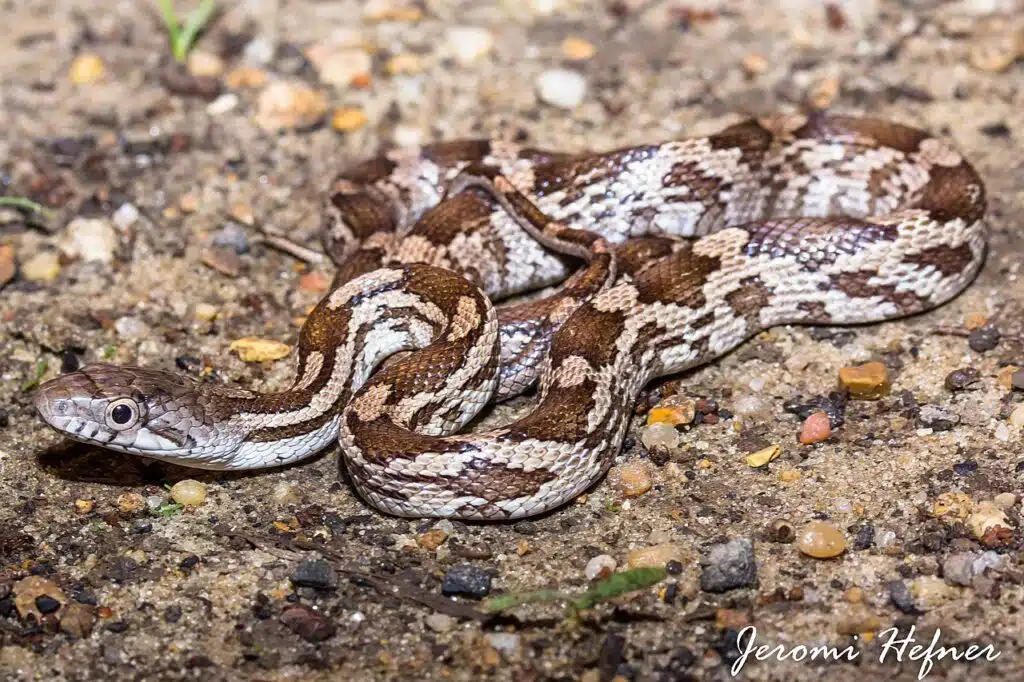
Gray Ratsnakes (Pantherophis spiloides) have consistent populations across New York and a threatened status in other states such as Michigan.
This is a species living around woodlands. Agile climbers, Gray Ratsnakes can easily make their way up trees.
Finding food is one of the main reasons the snake climbs trees.
It feeds on eggs and birds it can find in bird nests across tree branches.
Gray Ratsnakes aren’t venomous but they possess different defensive techniques such as playing dead or remaining motionless.
This snake can also release a foul smell in the face of danger so that predators move away.
Gray Ratsnakes are also some of the largest types of snakes in New York.
They grow up to a few feet and a bit less than in captivity.
Gray Ratsnakes can grow to a length of up to 6 feet.
Identified by its bright body with dark blotches, this species lives for years and even more than a decade.
Females lay up to 27 eggs once they reach sexual maturity.
12. Smooth Greensnake
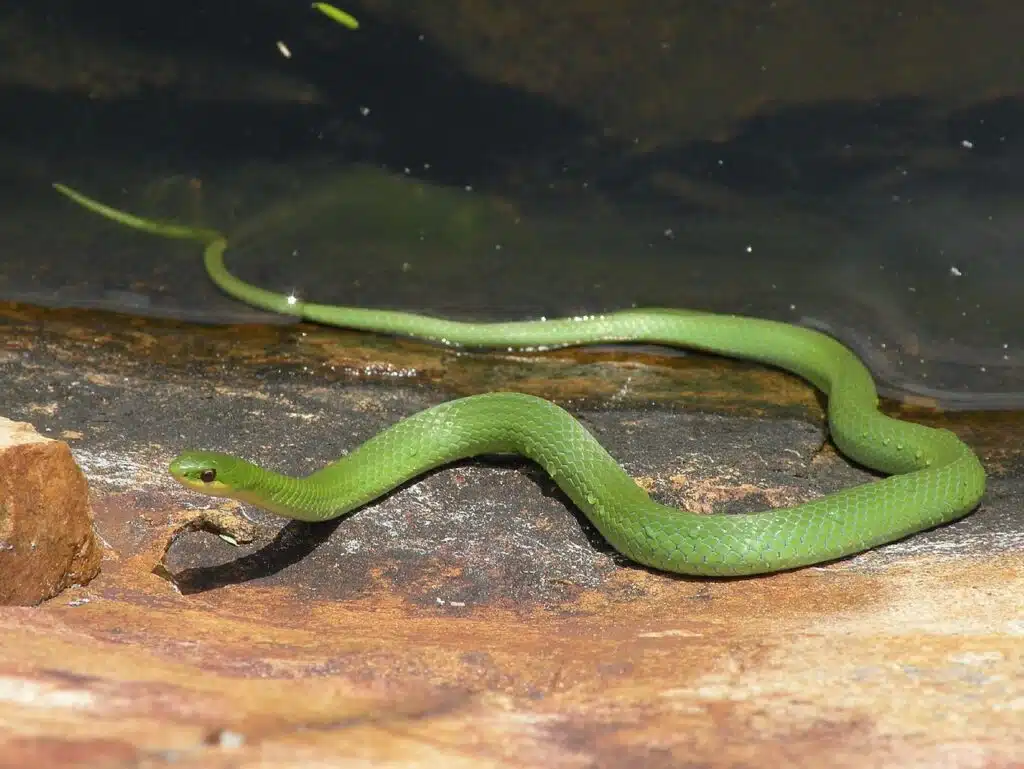
Smooth Greensnakes (Opheodrys vernalis) are named after their smooth uniform green bodies.
As some of the most common snakes that eat insects in New York, this species is known for having a reduced body size.
It grows to a maximum length of 14 inches, with many snakes of the specie measuring around 10-12 inches.
It has a bright green color covering its dorsal side and a bright underbelly.
Snakes of this species live on dry land and around marshes but it isn’t a fan of dense vegetation.
Smooth Greensnakes females can be seen in the summer and late summer when they lay eggs.
This species can also be seen when it’s out for food. All types of insects such as ants are part of its diet.
Spiders, including water spiders, are another common prey for the species.
To a lesser extent, this species also feeds on earthworms and small slugs.
Female Smooth Greensnakes use rodent burrows to lay eggs. They lay a limited number of up to 6 eggs per season.
13. Eastern Copperhead
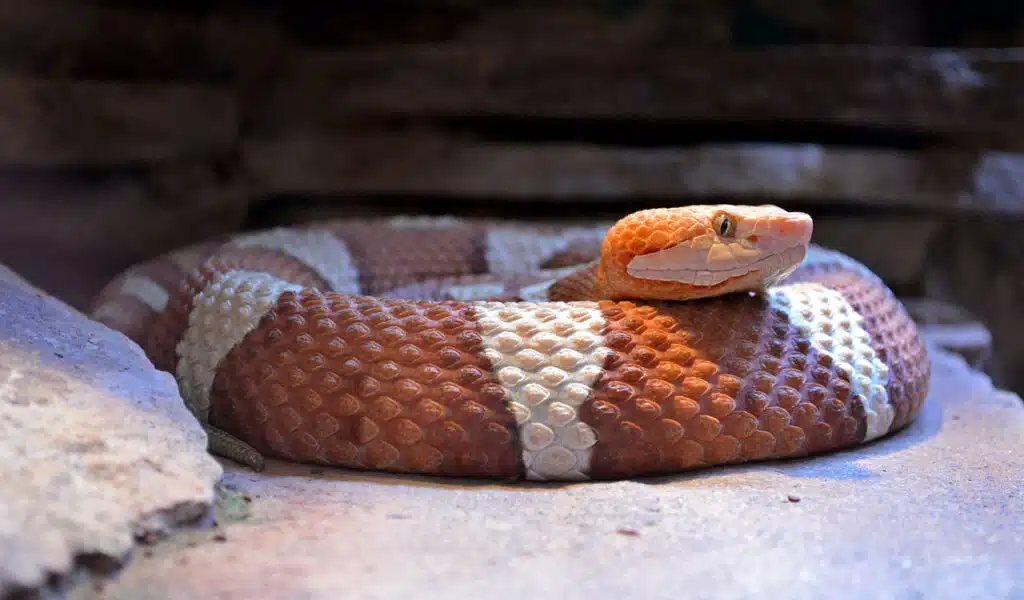
Eastern Copperheads (Agkistrodon contortrix) are one of the most venomous species in New York. This is a snake known for its heavy impact on human health.
While not deadly, an Eastern Copperhead bite still requires medical attention and antivenom in most cases.
This species has a body dominated by brown and gray colors. Its robust body is known to only grow up to a maximum size of 37 inches.
Decideous forests and mixed woodlands are its most common habitats.
It’s here that the Eastern Copperhead finds a good selection of vertebrates and invertebrates to feed on.
This species can be encountered by humans out around woodlands and it can be differentiated by others by standing its ground.
While other states in New York flee when seeing humans, Eastern Copperheads remain motionless as they try to make the most of their camouflaging colors.
This is also how the species hunts.
It uses ambushing techniques by waiting for prey motionless for long periods.
Female Eastern Copperheads are known for having to vary specific mating habits.
For example, female snakes don’t reproduce every year even after reaching sexual maturity.
They give birth to live young but may later live for years without giving birth to other snakes.
14. Eastern Hognose Snake
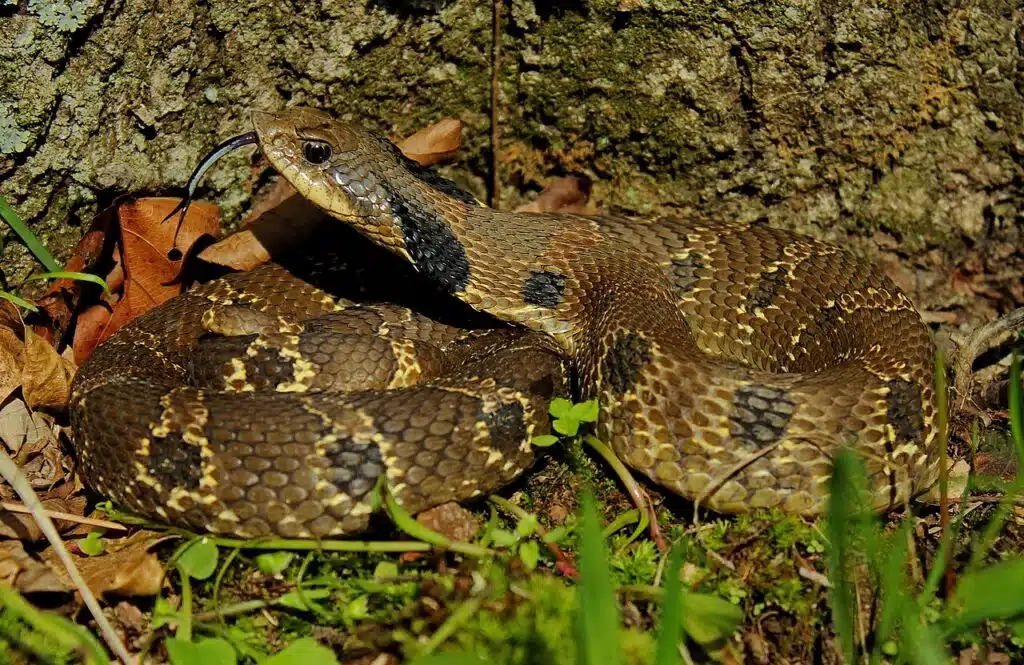
Eastern Hognose Snakes (Heterodon platirhinos) are native to the state. They come in different colors such as black, orange, red, brown, gray, white, or combinations of these colors.
Rear-fanged, Eastern Hognose Snakes are known for their mild venom which is similar to the venom of amphibians.
The snake is often spotted in the position of a cobra.
It flattens its head and raises it when facing humans and any other animals or perceived threat.
This is a species that may also attempt false bites or attempted bites.
It moves its head quickly butting the animals or humans to mimic a dangerous bite.
Eastern Hognose Snakes are found in different types of woodlands and along woodland edges.
This species feeds on toads across these habitats. It can also feed on poisonous toads as their toxins don’t affect the snake.
Eastern Hognose Snakes also eat salamander. This is another common prey for snakes living around woodlands due to the higher humidity levels in dense vegetation.
Mid-summer marks the mating season of Eastern Hognose snakes.
Female snakes lay up to 40 eggs before the end of July. The eggs hatch by the early days of the fall.
15. Short-headed Garter Snake
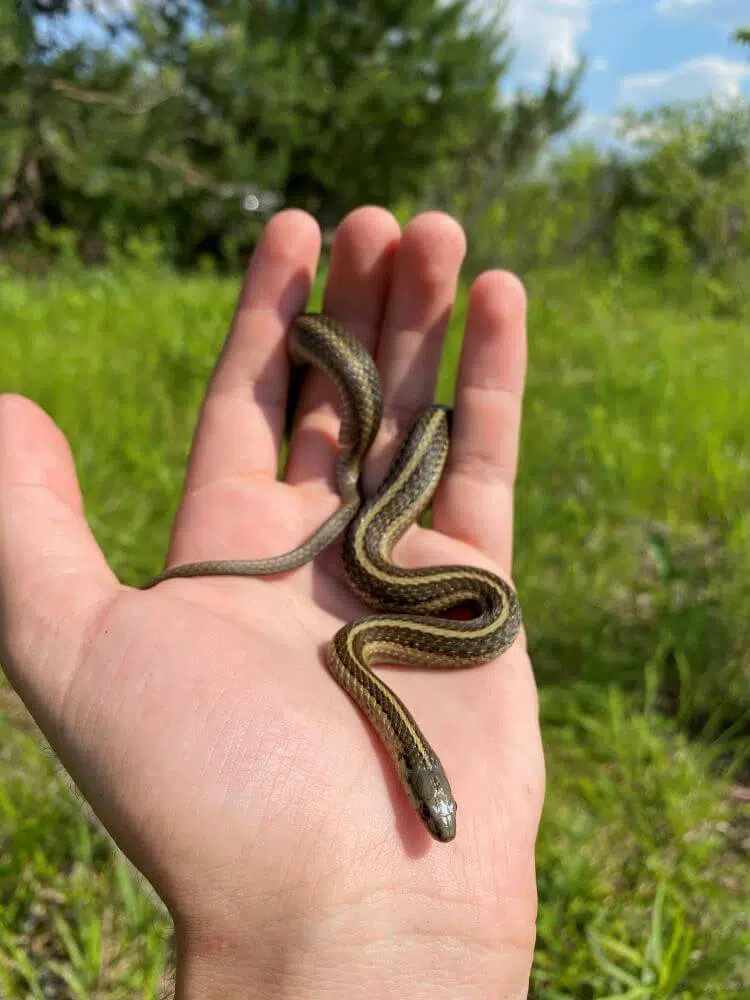
Short-headed Garter Snakes (Thamnophis brachystoma) have a striped contrasting body.
It grows to a short size of up to 26 inches while smaller Short-Headed Garter Snakes measure around 20 inches.
Various habitats are covered by the species. It lives in woodlands and different types of open habitats.
Various types of dry and humid habitats may also be visited by this snake looking for food.
Salamanders are among its most common foods.
This snake can also eat small fish as well as a range of other invertebrates around bodies of water.
The prey Short-headed Garter Snakes can swallow is limited. A small head that’s just as wide as the rest of the body is specific to the species.
16. Eastern Worm Snake
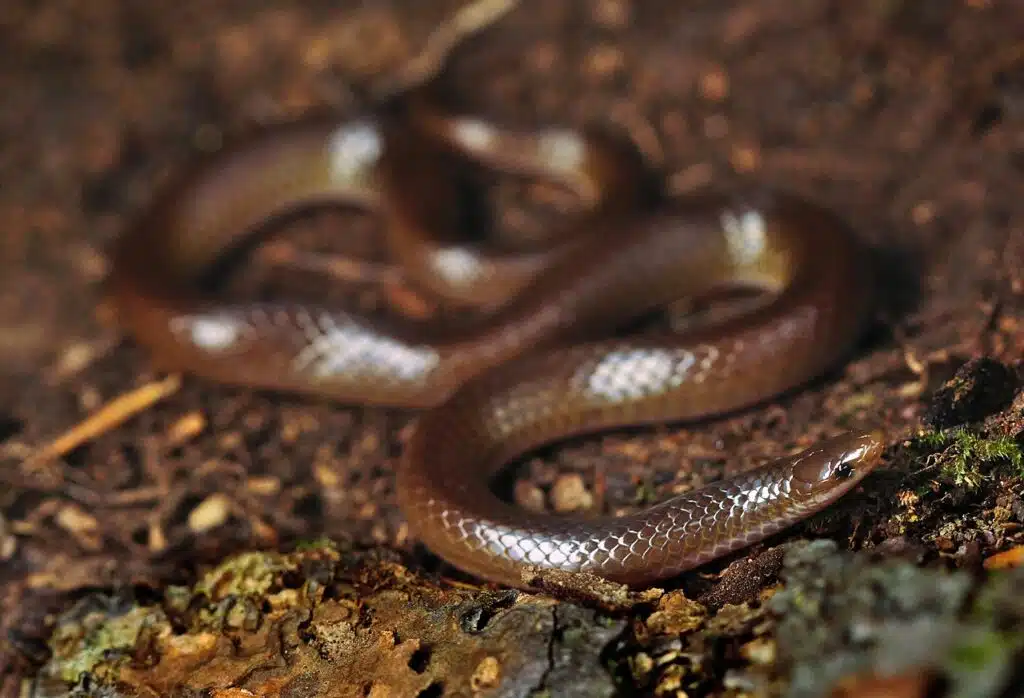
While large populations of the Eastern Worm Snake (Carphophis amoenus) can occur in Southeastern New York, this species remains elusive.
Its fossorial living means it spends a lot of time underground or moving under leaves or in loose soil.
The fossorial nature of the species also means the Eastern Worm Snake has a brown to black dorsal color matching its habitat.
A pink or red ventral color is also specific to the snake.
Rarely seen at ground level, this snake is known for moving short distances every day.
Its activity levels cover about half of a day. In this interval, the snake only covers a short distance of up to a few tens of yards.
While slender and short, this species cannot cover vast grounds as its fossorial.
The snake grows to a maximum length of 11 inches.
17. Massasauga
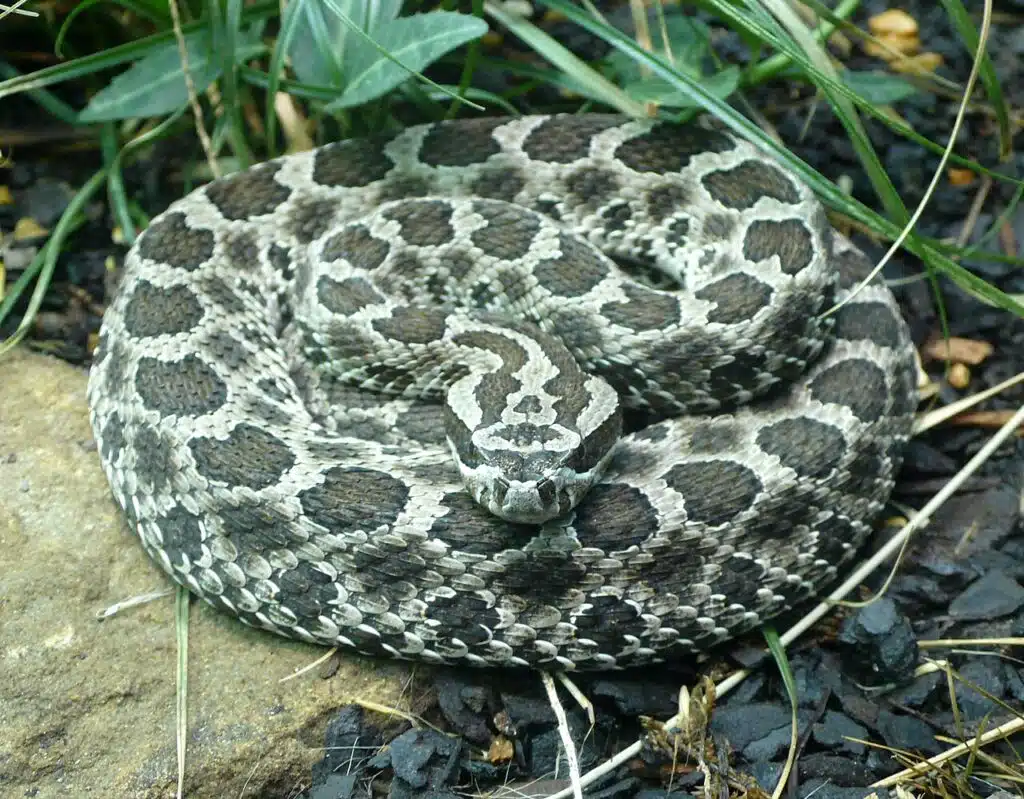
One of the most dangerous snakes in New York with an endangered status is the Massasauga species (Sistrurus catenatus) .
This is a tendency the species is known for even across the world as it’s now gone from about half of the territories it used to live in.
This species has a gray or tan color with a body covered in dark blotches.
Snakes of this species have an impactful venom. It destroys tissue making the species truly dangerous for humans.
While endangered in New York and mostly out of inhabited areas, this snake can still pose a serious threat to those coming in contact with it.
Massasaugas are found in Northwestern parts of New York. It’s here that they live in proximity to The Great Lakes.
More recent studies show Mssasaugas don’t travel more than tens of miles away from the area of The Great Lakes. They might only be looking to move along other water sources.
Woodlands and shorelines are areas where the species may still be encountered.
18. Queensnake
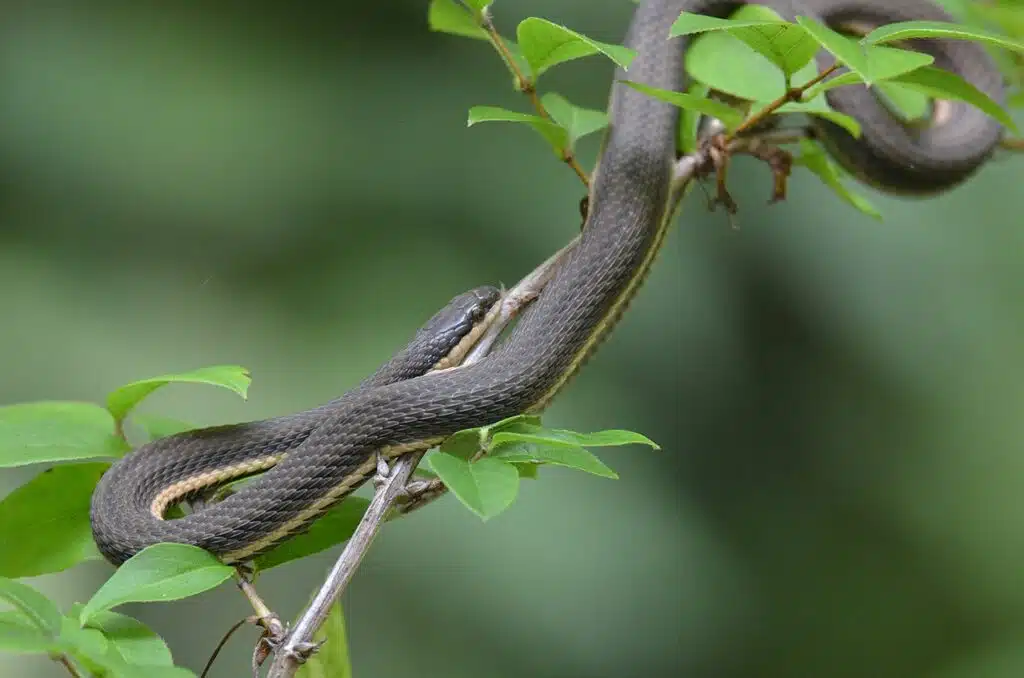
Queensnakes (Regina septemvittata) are beginning to be a rare sight in New York. They have an endangered status in the state and are mostly still seen near bodies of water.
Only clean streams and water that isn’t polluted are preferred by Queensnakes.
The species feeds on crayfish which also like clean water.
This colubrid species doesn’t have any venom but it may still bite.
Its size varies considerably. The average 22-inch size of the species is considered standard in the state and other regions of the country.
Female Queesnakes give birth to live young. They start mating in the 3rd year with males that become sexually mature sooner.